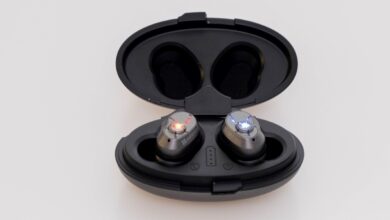Simgot EN700 PRO IEMs Review
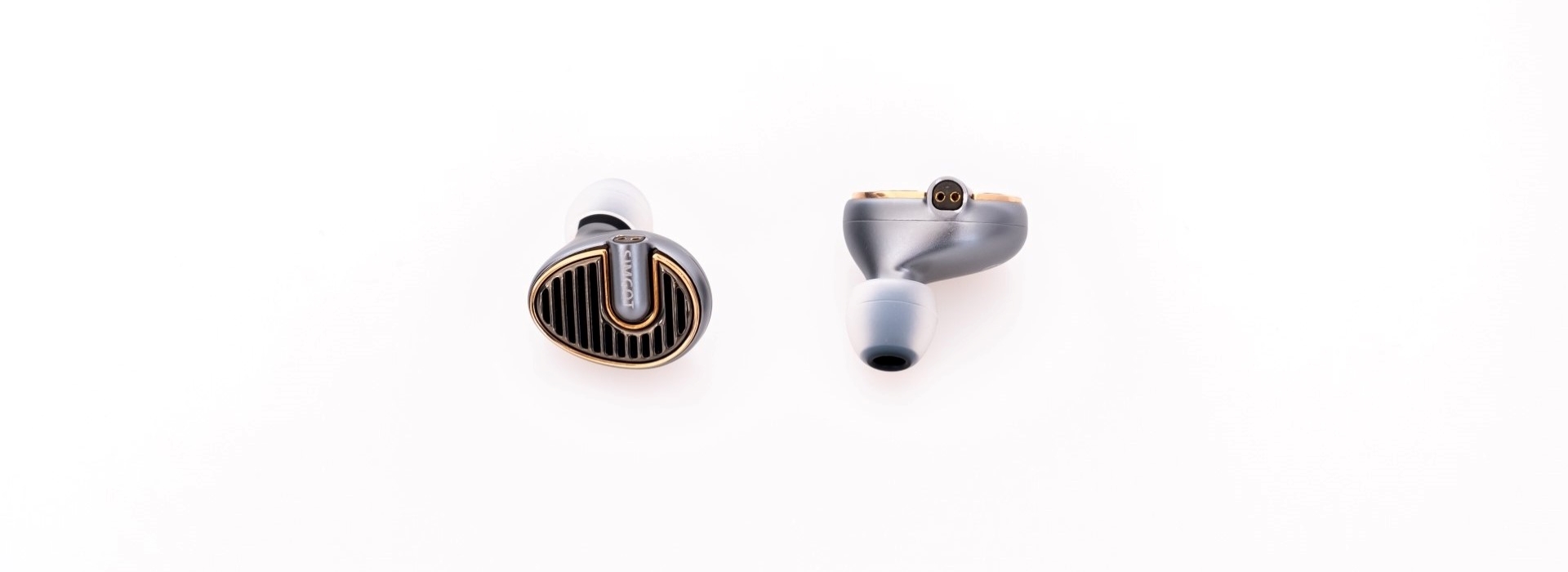
My video review:
Disclaimer: Simgot EN700 PRO were sent to us free of charge in exchange for our honest opinion. We thank Alan from team Simgot Technology for this opportunity.
Alan recently fist-bumped into us and introduced to the Simgot family and I’m glad he did that, as this is our first gig and our first meet and greet with Simgot family of IEMs. Simgot Technology is a fairly new company, founded just 4 years ago, their name also means Simple and elegant. On their home page they pledged with: “We trust only finest product and perfect service, only the fusion of old-school rules and fashion creativity. Don’t give in to conservative and troubles, we will redefine your senses. Stop step around and start set out. Salute to art and science.”
Today we will be testing their EN700 PRO In-Ear-Monitors – the flagship IEM that is coming from a bigger family of products. From the the groovy and bass-enhanced EN700 BASS to the standard EN700 that were already improved with the MKII version and to the best in class EN700 PRO that arrived at our font door about 3 weeks ago.

Unboxing experience & Package contents
EN700 PRO came in a quite unique black box. Matte at color, the IEMs will reveal themselves on the box only from an angle, the big and bold Hi-Res logo on the upper left corner shows some proudness and accomplishment. Inside there is another, much thicker box with lots of foam protecting the IEMs themselves. The unboxing experience is quite positive as first thing that caught my attention was a high quality real-leather carry case, on the back of it they imprinted the company motto “Salute to Art and Science”.
Inside the leather case 6 pairs of ear-tips can be spotted that are split into 2 categories:
- Eartip 1 is having S, M and L sizes of ear-tips and will enhance the mid and high frequencies, offering a crystal-clear sound with a high resolution.
- Eartip 2 will however boost the bass and will offer a superior listening comfort. These ones should attenuate a bit of treble for a natural and bass-driven sound.
We will be testing, listening and measuring their performance with both types of ear-tips.
In the case a detachable cable can also be spotted, it has a nice quality but I consider it thinner than usual, the headphone plug looks stylish and left a positive impression on me.
The thicker foam is holding the IEMs in place. I must add the IEMs are looking quite unique and very different from anything I’ve seen until now, that is really good since I can distinguish them easily from any other IEM brand.
Underneath the thicker foam all the paperwork can be found as the global warranty card, a guide explaining how to insert them, some tips on listening on higher volume and some general information on them. This is basically it; I’d wish two things could be added in the future: a simple headphone adapter to use them with desktop gear and maybe another 3 pairs of memory foam ear-tips (love those a lot).

Looks & Build Quality
As I mentioned, EN700 PRO and all the IEMs in the EN700 range have a particular design language that I never spotted on other IEM brands.
Simgot got 4 color variations for them, we got the gun-metal grey ones which are looking really nice. The whole IEM body is made out of metal using Series 7 aviation aluminum that was carved using a 5-axes CNC engraving milling machine and the outer grill was made from MIM stainless powder.
It is common practice already eliminating the air pressure between the ear canal and the IEM assembly so EN700 PRO are having a small hole to eliminate all the pressure, this is a big comfort enhancement that was firstly introduced in IE800 by Sennheiser few years ago. The IEM cable connectors are flushed a bit so those are safe from dust and thin particles. The IEMs have a standard sized metal nozzle so all the third-party ear-tips will work with them. I tested few Spin-Fit and memory foam ear-tips and all worked nicely with EN700 PRO. If you are having a big ear tip collection as I do, you can use all those without an issue.
As for the cable, Simgot made an interesting marriage between a single crystal copper conductor and another silver-plated conductor to create a braided cable that should offer sound benefits of both copper and silver. Our gun-metal grey IEMs came with a black PVC insulator on the outside of the cable, so this particular IEM color is not having a transparent insulator to see all the copper and silver goodness, go for a blue or red color to have a transparent looking cable.

Tech inside EN700 PRO
The IEM shell is quite small because this is an all dynamic driver In-Ear-Monitor. The diaphragm is made out of polymer composite that was titanium plated to increase rigidity and moving speed. Simgot is quoting a 15 Hz to 40 kHz frequency response, will see about that in a minute. The diaphragm is being moved by a powerful N50 neodymium magnet.
Since this is a single dynamic driver IEM, no additional cross-over circuitry was needed, the signal from the source is going directly into the driver assembly and nothing stands in its way. I expect EN700 PRO to have a speedier presentation with a nice kick and impact.
Having an impedance of just 16 Ω and a sensitivity of 101 dB per 1mW of power, anything that has a headphone jack can move its diaphragm to really loud levels. Even small portable DAPs like FiiO M5 and M6 were more than capable of fully driving the EN700 PRO, if you have a lower power source you should not worry too much. This IEM is rated only at maximum 10mW, more than that and you could damage its driver. Modern smartphones that still have a headphone jack are offering about ~20 mW of power into 16 Ohms, to this tells a lot about EN700 PRO sensitivity.

Comfort
Since EN700 PRO has quite a small metal body, the comfort levels are high. To me these ones were among the most comfortable IEMs I had the pleasure of testing. The outer shell is not touching my ear and is not putting any pressure on the ear-canal. The stock silicone ear-tips are Ok if you are not inserting them too often, I used the smaller ones. For improved comfort memory foam ear-tips are quite better since they are taking the shape of the ear canal, even Spin-Fit ear-tips were better than the stock ones.
Sound Performance
The overall impression is that indeed EN700 PRO has a speedier and snappier presentation. It sounds much faster than regular cellulose dynamic driver IEMs. As a direct result they kick a bit harder and have an impressive bass slam, especially for a very small driver like this one. The only thing that had a longer decay compared to the rest of the spectrum was the bass, it lingers a bit more and attracts a lot of attention to it because of that.
The combination of a really nice conductor cable and the titanium plated diaphragm resulted in a clean and detailed presentation. The EN700 PRO are very much into clean, wide spread and detailed sound and are far away from muddy or boring sounding.

Simgot EN700 PRO has 2 types of ear-tips, since each type is having different acoustic properties, I will split my review in two.
Eartip I
Simgot calls them powerful mid-high frequency with a crystal-clear sound, I am however calling them simply treble ear-tips. After listening to them for few days I tend to agree with this short description. With these tips they are sounding a bit W-shaped to me, with a mild rise in the mid-bass, a slope in the upper-midrange and a clear emphasis in the treble area to boost the higher pitched details a bit.
When it comes to sub-bass, I am quite surprised my usual bass tracks revealed a lot of information in this area. I would not characterize them as truly linear-as a ruler in the sub-bass area, but lows are quite present and airy, having a clear and defined sub-bass. Even tracks that are not enhancing the lowest end like Radiohead – No Surprises had it impressively deep, layered and detailed. I consider its sub-bass performance good and just a smidge away from great. The only thing that kept them away from great was a small drop in energy in the 20 to 50 Hz area and a longer bass decay, that can’t be dealt with, don’t forget this is a dynamic driver and it needs a bit of time to stop from moving (as opposed to a balanced armature).
Mid-bass performance is better and could be considerer one of its highlights, with Eartip 1, I am hearing a deep reaching and very present bass response, very close to a linear-curve. It may be boosted but very gently, just a 2 dB or so boost to lift the mood and add a bit of warmth into the mix. With modern music, EN700 PRO are kicking really nice in this department and are sounding fast, engaging, mildly warm and inviting, I like it.

Midrange performance is like a double-edged sword. On one hand the lower midrange is really good, the transition from the upper-bass to midrange is done in a smooth and musical fashion without drops in the FR, or in the speed of delivery. Lower midrange adds again just a bit of soul in the overall musical performance. Male voices are sounding heavy and imposing and carry a lot of weight to them.
On the other hand, the upper-midrange sees a slope and adds a hollow effect to the overall presentation. Male voices sounded really nice and imposing, however higher pitched female voices are losing energy and are making a step backwards in the background. This is not very obvious, but the more you listen the more you start realizing that something is missing a bit.
In EN700 PRO defense I will state that they sounded again very clear, with lots of air around those notes and as much as I wanted to blurry their performance with fast and crowded music, I couldn’t make them muddy or slow sounding.
Since the upper midrange is lowered in energy, the lower treble has just a small drop in energy as well but soon it starts rising to linear levels and starts sounding really crisp, quite impressive actually.
The mid-treble sees a rise, hence my W-shaped statement and adds the impression of really clean and very detailed sound. Everything from drums, to snares, cymbals and bells carry a little bit more energy and are calling for more attention from the listener. As a result, few tracks will sound brighter than usual and might shoo away few listeners.
Do keep in mind that this is a really engaging type of sound, V or W shaped type of signature always induced a bit of euphoria and enjoyment and EN700 PRO is not an exception from that rule. The slope in the upper-midrange and rise in the mid-treble is exchanging fullness with a better airiness and detail retrieval. I prefer linearity, but I do love engaging and colorful presentations as well, EN700 PRO is a very good example of that.

Eartip II
Simgot calls them as having enhanced bass and superior listening comfort, neutral and bass-driven sound, but again I’m calling them simply bass ear-tips.
After an hour of testing back and forth between the treble and the bass ear-tips, I came into the conclusion that indeed the Eartip 2 is having a better sub-bass performance.
With these ones I am changing the description from good to great sub-bass performance. The notes in the 20 to 50 Hz area carry more energy, can be easily spotted and are very linear as a ruler compared to the rest of spectrum. Sub-bass is slamming even harder, carry a bit more air and lingers a bit longer as well. This is a very mood lifting sub-bass performance and all the cons I had with the treble ear-tips were solved with these ones.
Mid-bass performance this time around is on the same level with sub-bass and again grabs your attention. All the bass region sounds as a single entity and moves with the same speed, the overall bass performance is impeccable with this particular ear-tips, just make sure to have a better seal and you are good to go.
The lower-midrange slope is not that pronounced anymore and the hollow and dryness effect is not that defined. There is still a slope that moves the musical notes a step back in this region but it is smoother somehow. The rise in the mid-treble is still there and it is quite pronounced.
The mid-treble again takes the reign over the frequency response as again the drums, snares, cymbals and bells will have a higher density, will carry more energy with every kick and are attracting a lot of attention to them.
However, there is an interesting side effect: boosting the bass response, especially the sub-bass response resulted in a lower treble rise and a lot of the treble energy and attention was moved to the bass area, so overall everything sounded more cohesive and not as emphasized.

I personally feel this is the ear-tip for me, it is more honest sounding compared to my linearity curve and overall sounds more coherent and truer to life.
Treble ear-tips are artificially enhancing the treble response to have the feeling of better airiness and detail retrieval but I consider bass ear-tips as detailed and clear sounding, those are just not showing off those details as much. It is a preference thing really, use the ear-tips you like them most.
I will continue describing the rest of EN700 PRO performance using the Eartip II.
EN700 PRO have a wider than usual soundstage size, not impressively huge but big and wide nonetheless. I really this this, since all the classical pieces are sounding outside of my head and quite layered. Picking sounds from the recording is not that hard, just close your eyes and listen to your favorite instrument. Most of my listening time was made via the Benchmark HPA4 that actually boosted its soundstage size and increased depth. With some mobile sources, it was reduced in size and everything sounded not as enveloping, not around my head but more like inside my head.
In this respect EN700 PRO are quite different sounding and will respond well connected to a better audio source, the better the source will be, the better they will sound.
Transient response is actually great, everything sounds snappy, quite fast, without longer decays. Only in the bass region I felt a longer vibration than needed. Lack of complicated cross-over made them sound extra fast and dynamic. They keep up with double-drums and with double bass, in my book that is as fast as they need to be.

Measurements
I decided to measure EN700 PRO and see for myself how big is the difference between Eartip I and Eartip II.
I needed to most linear source and amplification, for that I used a Matrix Element X as a DAC and a Benchmark HPA4 as the headphone amplifier, both are measuring as a straight line so any deviations in the graphs are from the EN700 PRO themselves.
I used a MiniDSP E.A.R.S. as the measurement rig and REW V5.1 using IDF (IEM Diffuse Field Compensation) files.
And here are my raw measurements, Red is Eartip II (bass eartip) and Green is Eartip I (treble eartip).
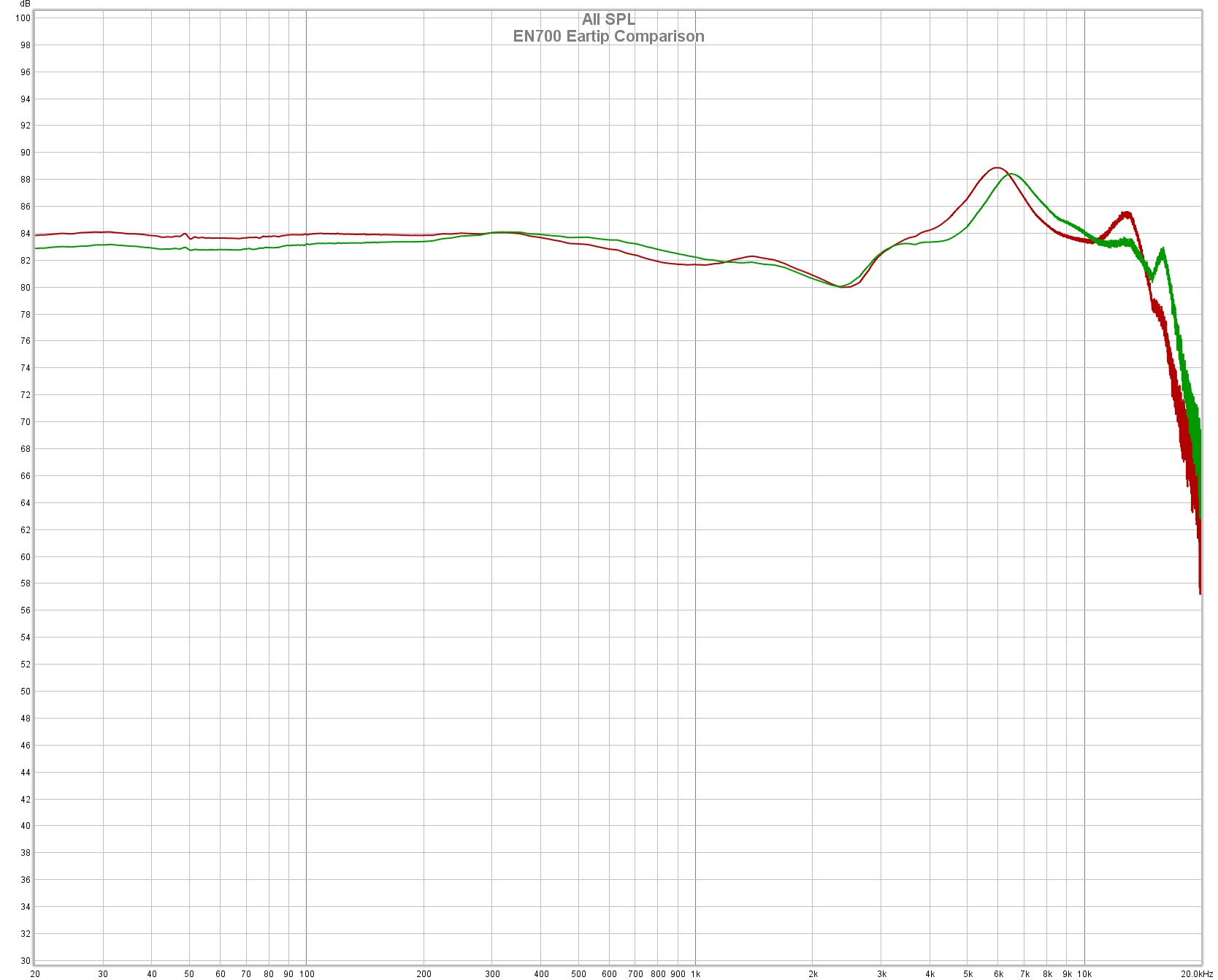
As you can see, the difference is not that big, but of course there are some interesting aspects. As expected, Bass ear-tips have a better sub-bass performance, by about 2 dB more energy, there is also a smaller slope in the upper midrange. What was quite unusual is that the bass ear-tip enhanced the treble by about 3dB more in the 12 to 13 kHz area compared to the treble ear-tips.
In exchange, treble ear-tips have an interesting rise and sustain at the 16 kHz area, that enhances the feeling of clearer details and airiness.
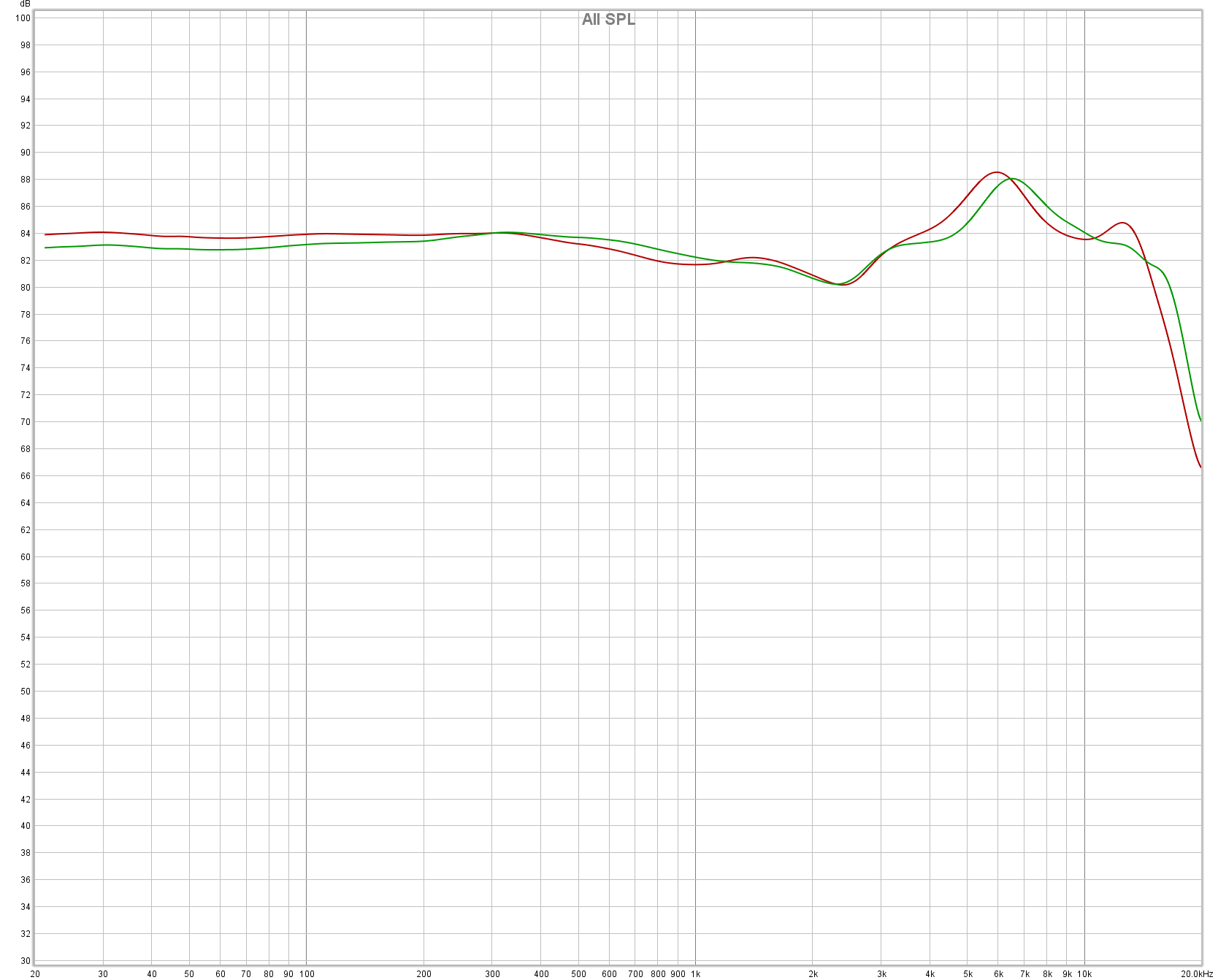
Here is the same graph but with a 1/12 smoothing applied. All in all, EN700 PRO are quite linear sounding up to lower treble where things are starting to be jumpy…
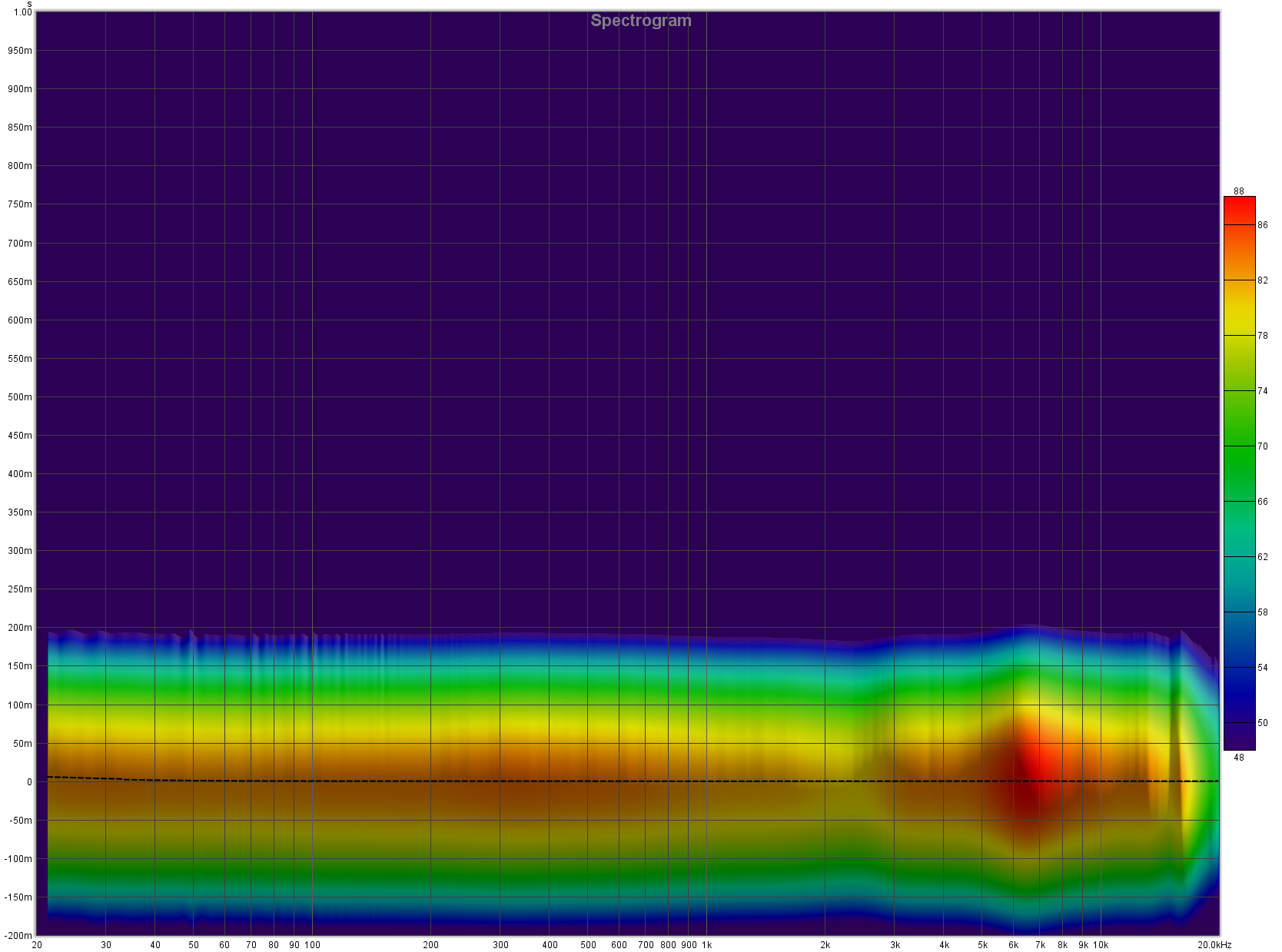
The next is the spectogram reading (with bass ear-tip) it shows that EN700 PRO are really clean sounding, without ripples in the bass, this is a really clean sounding IEM, not a single sign of muddiness.
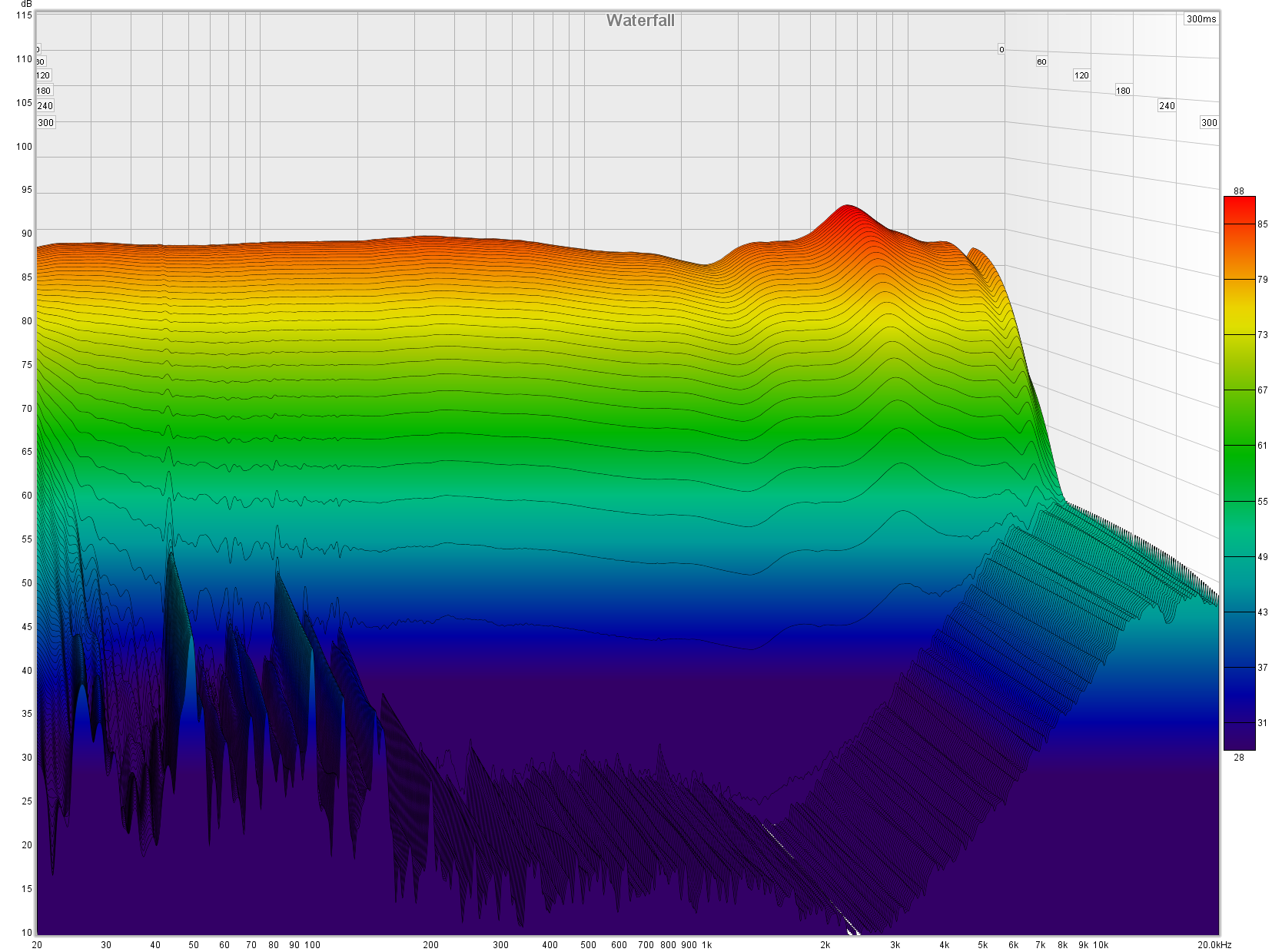
And lastly, the waterfall reading (with bass ear-tip) shows all the higher energy EN700 PRO is having, especially the rise in the 5 to 6 kHz is very visible. The blue mountains are showing a longer bass decay as I expected and felt with my listening tests.
All in all, measurements are showing only a small part of a bigger story, measurements can’t really show detail retrieval or how clean they might sound but are good to have.

Comparisons
EN700 PRO (~$150) vs KZ AS16 (~$130)
In terms of design Knowledge Zenith AS16 uses a much bigger shell, and only the outer part is made out of metal, the rest is hard resin (plastic). AS16 are not are comfortable as they are heavier and push my ear-lobe, their IEM nozzle is a bit unusual, longer than normal so few ear-tips will not fit in.
The packaging and the accessories are poorer on AS16 and they didn’t came with a carry case.
In terms of sound, KZ AS16 have a dry and bright sound signature, very uneven, or may I say the most uneven IEM I ever tried 🙂
They have poor sub-bass performance and not a lot of rumble in the bass department. The sound very ethereal and lightweight. Every note sounds too light for my tastes, piano sounds really poor and everything is just weightless. Midrange is a bit better and will not have a hollow effect, probably the best part of KZ16 is the upper-bass and all the midrange area, everything else is quite a mess.
Treble is boosted by up to 10 dB to induce teeth clenching brightness and a lot of bad language. KZ AS16 are sounding quite bright, dry and don’t have a good bass response. The only thing that can be considered good is their speed performance and their depth and soundstage levels. In terms in frequency response KZ AS16 are a far cry from linearity.
EN700 PRO are better in term of sub-bass, mid-bass, even upper midrange is more linear. EN700 PRO have also a boost in treble area, but not a super exciting 10 dB boost, according to my graphs EN700 PRO at the worst point have the treble boosted by 4 dB, that is very reasonable and very humanly normal. EN700 PRO are sounding much more linear, much more honest and even clearer. EN700 PRO have the same soundstage levels and depth (with the right source) and have an out of head presentation with the right music and gear.
EN700 PRO is just a much better IEM than KZ AS16, sorry KZ lovers but that is the ugly truth.

EN700 PRO (~$150) vs IKKO OH1 (~$140)
In terms of design OH1 is really beautiful as well, with an all metal shell, it has a really nice build quality with good attention to details. They also have 6 pairs of ear-tips put in 2 categories and they also have a velvety carry case.
In terms of comfort I would rank both on the same level, both are really lightweight and are not putting a lot of stress onto my ear and ear-canal.
In terms of sound quality this will be a hard battle, since OH1 were excellent sounding at that price range.
Sound wise OH1 is tuned towards fun and musical, they are mildly warm sounding as well. OH1 have more presence in the sub-bass area, it is quite an elevated sub-bass performance. Mid-bass is much more linear and truer to life, it is basically on the same level with EN700 PRO. When it comes to bass, EN700 PRO has it more linear and it is not boosted at all, I like the EN700 PRO bass more as it follows my personal linearity curve.
Lower midrange resembles a lot that of EN700 PRO, there is also a slope and there is also a rise in the lower-treble area, so at this region it is again a tie. I consider them both having a nice midrange, but not a magical and full-sounding midrange.
The most interesting aspect is the treble area. Both have a rise in the mid-treble area. However, OH1 is having it in the lower 2 to 4 kHz part and the rest of the treble, especially the sub-sonic treble is unimpressive. Even cymbals and bells are losing energy and information on the OH1. As I was telling, OH1 was tuned towards fun, musical and warm, not towards linearity.
Simgot EN700 PRO is truer to linearity and to my curve as it has a little more energy in the 5 to 7 kHz area and more of it in the 16 kHz area.
Soundstage size EN700 PRO has it a bit wider and deeper and in the detail retrieval EN700 PRO is again better as it shows just more micro-information on the audible spectrum.
EN700 PRO is overall better in most departments and will impress casual listeners and audiophiles alike, OH1 is mostly targeted towards casual listeners.

Conclusions
Going on into the conclusion I do think that at $150 there is almost nothing to complain about them, but a lot to like about EN700 PRO. Overall, I consider them better than its close competitors not only in terms of build quality and in terms of sound quality as well. You can buy them directly from Amazon or from AliExpress.
PROS:
- Excellent packaging and selection of accessories
- Awesome fit and finish, high comfort levels
- Wide soundstage size with lots of air around the notes
- Linear sub and mid-bass performance, great bass slam and control
- Extended treble performance, lots of sparkle up top
- Good detail retrieval and transparency
- Alive and engaging sounding
- Extremely easy to drive
- Great performance at this price point
CONS:
- A drop in the midrange causes it sounding lean and dry at times
- A drop in the lower-treble as well
ASSOCIATED EQUIPMENT:
- DACs: Topping D70, Matrix Audio Element X
- Headphone amps: Benchmark HPA4, Erzetich Bacillus, Headamp Gilmore Lite Mk2
- IEMs: Simgot EN700 PRO, IKKO OH1, KZ AS16
- Portable headphones: Sennheiser Momentum 2.0, Master&Dynamic MW65
- Full-sized headphones: Hifiman Arya, Quad ERA-1, Sennheiser HD660S, OLLO Audio S4
- Loudspeakers: KEF LS50W
- Interconnects: QED Reference XLR (x2), Aune AL3 XLR
- Power Cables: Isotek EVO3 Premier (x2)
- Balanced Power Conditioners: PLiXiR Elite BAC400, KECES BP-600



